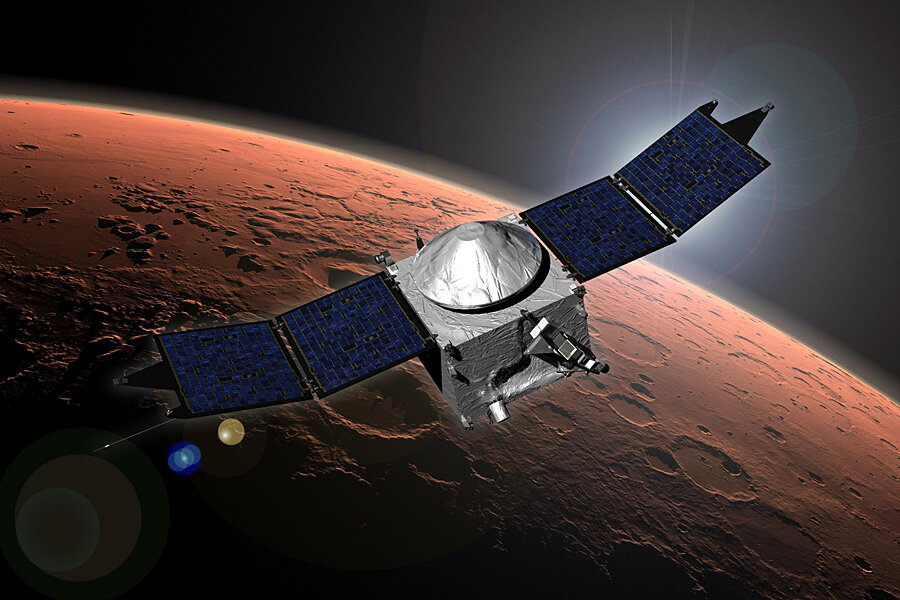MAVEN now successfully orbiting Mars. What's next?
Loading...
NASA's latest mission to Mars – an orbiter designed to help scientists reconstruct the history of the planet's atmosphere and the effect its changes had on habitability – has moved into its initial orbit after a 10-month journey that covered 442 million miles.
The craft, known by its acronym MAVEN (Mars Atmosphere and Volatile Evolution), began to orbit Mars at 10:24 p.m. EDT Sunday. It is the first of two orbiters slated to arrive at the red planet this week.
The second belongs to interplanetary newcomer India, which launched its Mangalyaan spacecraft on Nov. 5, 2013. The craft passed a test Monday after controllers briefly fired its main engine in preparation for the attempt on Wednesday to slow the craft so Mars' gravity can capture it.
If successful, Mangalyaan will join the European Space Agency's Mars Express orbiter, as well as the National Aeronautics and Space Administration's Mars Odyssey and Mars Reconnaissance orbiters and the landers Curiosity and Opportunity. They're trying to piece together the story of Mars and its shift from a relatively warm, wet, habitable planet with a thick atmosphere early in its history to the chilled desert that humans observe today.
The quest to understand Mars "is really a quest of humanity," said John Grunsfeld, associate administrator for NASA's science mission directorate, during a briefing following MAVEN's insertion into orbit.
MAVEN's arrival came about with the ignition of its six main engines for a "burn" that lasted 34 minutes and 26 seconds, slightly longer than MAVEN's game plan called for.
Still, when it was over, MAVEN project manager David Mitchell, based at NASA's Goddard Space Flight Center in Greenbelt, Md., was among many happy campers associated with the mission.
"You get one shot with Mars orbit insertion, and MAVEN nailed it tonight," he said. Based on initial data coming back from MAVEN, the craft's orbit is very close to the 35-hour orbit that planners had hoped to achieve, with the craft's closest approach to Mars bringing it within about 236 miles of the planet's surface.
Beginning in a day or two, controllers will gradually shrink MAVEN's orbit until it takes about 4-1/2 hours and brings the craft within about 93 miles of the surface. This is the orbit that MAVEN needs to reach to fulfill its science goals.
While controllers gradually dial down MAVEN's orbit, the scientist team will test and calibrate the craft's suite of eight instruments. The team will also test communications gear aboard the orbiter that will allow it to act as a radio-relay station between Earth and the rovers Curiosity and Opportunity.
During this time, the team will have a chance to observe the effect of a comet's close approach to Mars on the planet's upper atmosphere.
The comet, C/2013 A1 Siding Spring, will pass within 82,000 miles of Mars on Oct. 19, giving MAVEN's scientists a chance to make measurements a few days before and a few days after the comet's closest approach. The results could open an initial window on the physics driving changes to Mars' upper atmosphere today.
This region and the solar wind's influence on it are thought to have played important roles in the case of the planet's missing atmosphere, noted Bruce Jakosky, an astrobiologist at the University of Colorado at Boulder and the mission's lead scientist.
"The climate has changed on Mars significantly over the past few billion years," he said. "We're trying to understand what the cause of that climate change has been. We're looking at the role 'escape to space' may have played in changing the atmosphere. In essence, our goal is to answer the questions: Where did the water go and where did the carbon dioxide go?"
Once data collection begins in earnest, around Nov. 10, it could take about three months to analyze the data sufficiently to provide some preliminary answers to the questions the team is asking, Dr. Jakosky says.
For now, however, he and his team are reveling in the arrival of a mission that began as a concept 11 years ago, doing so with all the enthusiasm of a kid launching himself out of the back seat after a long car trip.
"We're in orbit at Mars, guys!" he said.








